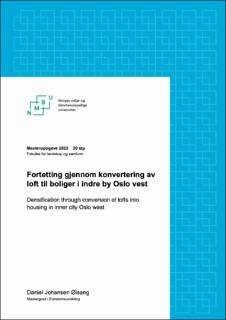| dc.contributor.advisor | Knut Boge | |
| dc.contributor.author | Øisang, Daniel Johansen | |
| dc.date.accessioned | 2023-07-19T16:28:04Z | |
| dc.date.available | 2023-07-19T16:28:04Z | |
| dc.date.issued | 2023 | |
| dc.identifier | no.nmbu:wiseflow:6839535:54591888 | |
| dc.identifier.uri | https://hdl.handle.net/11250/3080272 | |
| dc.description.abstract | Denne masteroppgaven har som formål å besvare problemstillingen «Hva er betingelsene for fortetting i Oslo indre by vest gjennom konvertering av loft til bolig?», ved å belyse følgende 5 forskningsspørsmål:
* Hvordan påvirker avstanden fra CBD Vest muligheten for konvertering av loft til bolig?
* Hvordan påvirker kommunens fortettingsstrategi muligheten for utvikling av loft til bolig i Oslo indre by vest?
* Hvilke faktorer må være til stede for at konvertering av loft til bolig gir nødvendig økonomisk avkastning?
* Hvilke fordeler og ulemper har konvertering av loft til bolig?
* Hva anser en eiendomsutvikler for å være de største utfordringene ved konvertering av loft til bolig?
Masteroppgaven er utarbeidet som en utforskende casestudie, hvor fenomenet «konvertering av loft til bolig» og dets betingelser utforskes med fokus på fortetting, miljø og bærekraft.
Byggesektoren produserer en stor del av verdens klimagassutslipp, og etablering av nybygg spesielt har en svært negativ effekt på klima og miljø. Uavhengig av dette så er det behov for flere boliger sentralt i Oslo. Studien har vist at det eksisterer et stort antall loft i Oslos sentrale soner, som er egnet for konvertering til bolig. I henhold til oppgaven kan konvertering av loft til bolig bidra til at det fortettes på en bærekraftig miljømessig måte, samtidig som eierseksjonssameier kan innhente kapital til rehabilitering, vedlikehold og oppgraderinger av bygårdene. Fordelene ved fortetting gjennom konvertering av loft til bolig er mange, men likevel er det å anse som en komplisert form for eiendomsutvikling. Som belyst i studien finnes det en rekke betingelser som må være til stede for at konvertering skal være økonomisk lønnsomt for eiendomsutviklere, samtidig som at den er givende for både samfunn, bygårder, eierseksjonssameier og beboere i Oslo indre by vest.
Studien indikerer at både Oslo kommune og planmyndighetene stiller seg positive til utviklingen av eksisterende bygningsmasse i Oslo indre by vest, samtidig kommer det frem at planmyndighetene stiller strenge krav til utvikling av loft. Dette bidrar til at konvertering kan bli ressurskrevende, risikofylt og økonomisk kostbart for eiendomsutviklere. | |
| dc.description.abstract | This master`s thesis aims to explore the question “What are the conditions for densification through conversion of lofts to housing in Oslo inner city west” by answering the following 5 research questions:
* How does the distance from CBD West affect the possibility of conversion of lofts to housing?
* How does the municipality’s densification strategy affect the possibility of conversion of lofts to housing?
* Which factors must be present in conversion of lofts to housing, in order to provide necessary financial return?
* What are the advantages and disadvantages of converting lofts into housing?
* What does a property developer consider to be the biggest challenges when converting lofts into housing?
The master`s thesis has been carried out as an exploratory case study, where the phenomenon of “conversion of loft to housing” and its conditions, are explored with focus on densification, environment and sustainability.
The construction sector produces a large part of the world`s greenhouse gas emissions, and the establishment of new buildings has a specifically negative impact on the climate and environment. Regardless of this, there is a need for more housing in central areas in Oslo. The study has shown that there are many lofts in Oslo`s central zones, which are suitable for conversion to housing. According to the study, loft conversion can contribute to densification in a way that are sustainable and environmentally friendly. It can also contribute to that condominiums obtain capital, through the sale of loft areas, that can be used for rehabilitation, maintenance and upgrades of the apartment building. The advantages of densification through conversion of lofts to housing are many, but it can still be considered a complicated form of property development. As highlighted in the study there are many conditions that must be present if conversion shall be financially profitable for property developers, while at the same time being rewarding for both society, apartment building, condominiums and residents of inner city west.
The study indicates that both Oslo municipality and the planning authorities are positive about development of and in existing buildings in Oslo inner city west. But at the same time, it appears that the planning authorities set strict requirements of the development of lofts. This entails that conversion of lofts to housing can become a resource-intensitive, risky and financially costly for property developers. | |
| dc.language | nob | |
| dc.publisher | Norwegian University of Life Sciences | |
| dc.title | Fortetting gjennom konvertering av loft til boliger i indre by Oslo vest | |
| dc.type | Master thesis | |
